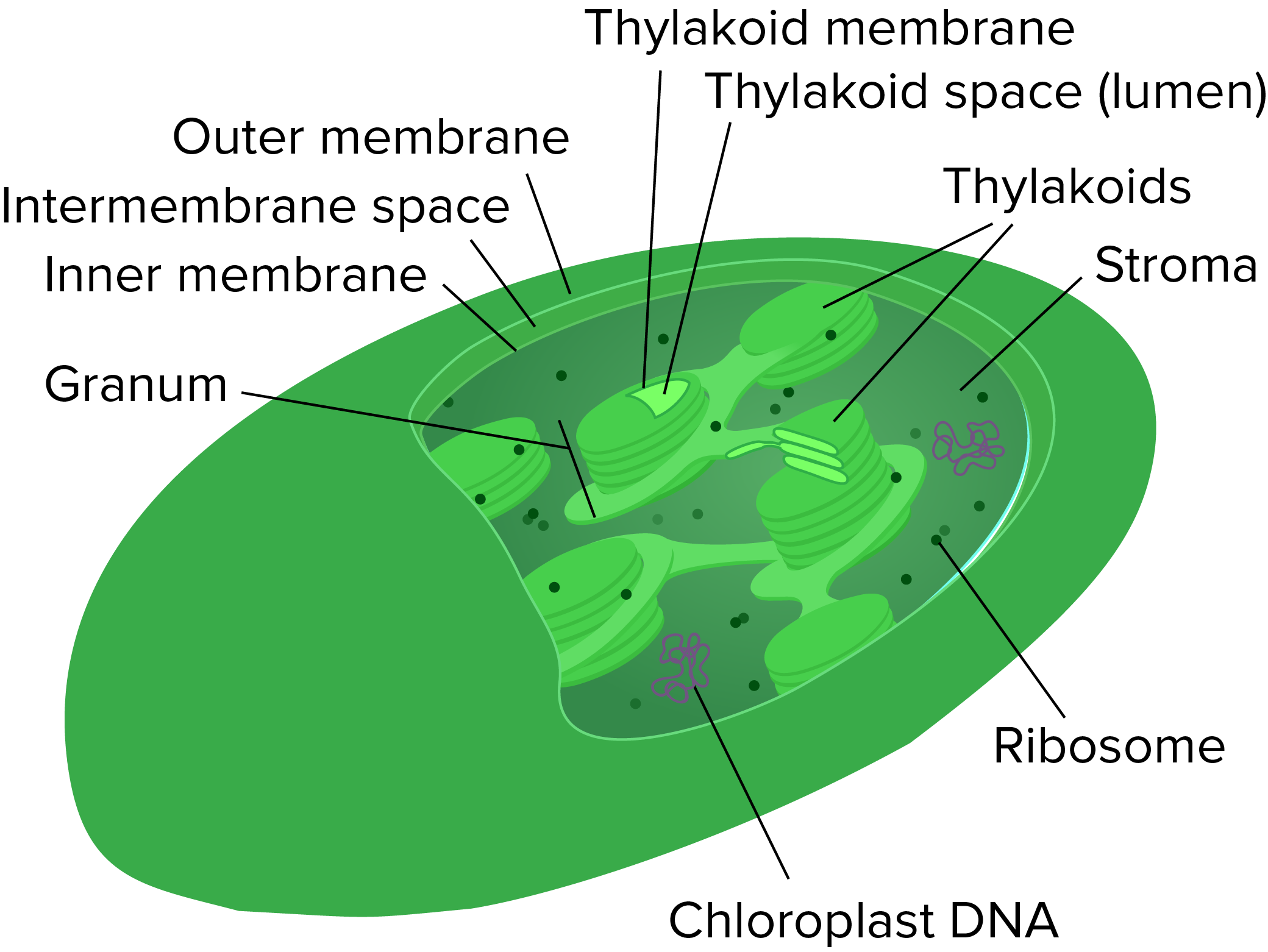Chloroplasts Study Guide
Check out awesome, educational VR rooms on Inspirit’s mobile app (available for iOS and Android devices)🤩
Introduction:
A chloroplast is an organelle found within the cells of plants and some algae. It is responsible for photosynthesis, which is the process by which solar energy is transformed into chemical energy for growth. A chloroplast is a kind of plastid (a saclike organelle with a double membrane) that contains chlorophyll for light absorption.
Chloroplast structure
- There are at least three membrane systems in the chloroplast: (1) the outer membrane, (2) the inner membrane, and (3) the thylakoid system.
- The outer and inner membranes form a double membrane system, a common characteristic of organelles.
- Thylakoids are disk-shaped structures that harvest or gather photons from a light source, such as sunshine.
- The antenna complex comprises proteins, and light-absorbing pigments like chlorophyll and carotenoids are embedded in the thylakoid membrane.
- As a result, the thylakoid’s role is to offer a location for photosynthesis’s light reactions.
- Granum is the name given to a stack of thylakoids that resemble a heap of coins (plural: grana).
- The chloroplast matrix is referred to as the stroma.
- It is the viscous fluid that exists between the grana.
- It is made up of enzymes, chemicals, and ions.
- It is the site of the light-independent process of sugar production (the dark reactions of photosynthesis).
- The chloroplasts, like the mitochondria, are semi-autonomous organelles.
- They have their own DNA, which is known as chloroplast DNA or cpDNA.
- As a result, they do not rely entirely on the genes found in the nucleus.
- They generate specific proteins from their DNA.
Where are chloroplasts located?
- Chloroplasts may be found in the cells of all green plant and algal tissues.
- Chloroplasts can also be found in photosynthetic tissues that aren’t green, such as the brown blades of gigantic kelp or the red leaves of some plants.
- Chloroplasts are abundant in plants, notably in the parenchyma cells of the leaf mesophyll (the internal cell layers of a leaf).
Conclusion:
- Photosynthesis is carried out by chloroplasts, and their primary function is to provide a venue for light and dark responses.
- Inorganic substances, water, and light energy are transformed into food, i.e., glucose, via these organelles (a sugar molecule).
- As a result, they are essential to photosynthetic species to produce food on their own and not rely on other creatures for survival.
- Because oxygen is a byproduct of photosynthesis, the chloroplasts are important for creating this gas, which is then discharged from the cell into the environment.
- Oxygen is physiologically significant due to its function in various biochemical and physiological processes in animals.
FAQs:
1. Do chloroplasts have DNA?
- Unlike most other organelles, chloroplasts and mitochondria have their own DNA.
- Chloroplast DNA comprises genes involved in photosynthesis and other chloroplast functions.
2. What is an easy definition of a chloroplast?
A chlorophyll-containing plastid in green plant cells where photosynthesis occurs.
3. How is chloroplast adapted to its function?
The chloroplast’s structure is tailored to the purpose it serves:
Thylakoids: Flattened discs have a limited interior volume to maximize the hydrogen gradient during proton buildup.
Grana: Thylakoids are stacked to enhance the SA: Vol ratio of the thylakoid membrane.
Photosystems: Pigments in the thylakoid membrane are organized into photosystems to maximize light absorption.
Stroma: The Calvin cycle takes place in a central cavity with adequate enzymes and a sufficient pH.
Lamellae: Links and divides thylakoid stacks (grana), increasing photosynthetic efficiency.
4. Why are chloroplasts found only in plant cells?
The chloroplast is unique to plant cells because plants are autotrophs that can create their food by converting light energy to chemical energy. It is the most important photosynthetic pigment in leaves because it converts light energy into chemical energy. It absorbs all electromagnetic radiations of various colors such as violet, blue, orange, and red. However, it reflects green light, making the leaves seem green. It absorbs solar light with wavelengths ranging from 430nm (blue) to 662nm (red). These are found in creatures other than plants, such as bacteria and green algae.
5. Why are chloroplasts called the kitchen of the cell?
Chloroplasts contain chlorophyll and carotenoid pigments that capture the light energy required for photosynthesis. As a result, the chloroplasts are referred to as the cell’s kitchen.
We hope you enjoyed studying this lesson and learned something cool about the Structure of Water and Hydrogen Bonding! Join our Discord community to get any questions you may have answered and to engage with other students just like you! Don’t forget to download our App to experience our fun VR classrooms – we promise it makes studying much more fun! 😎
Sources:
- Chloroplast. https://flexbooks.ck12.org/cbook/ck-12-biology-flexbook-2.0/section/2.19/primary/lesson/chloroplasts-bio/. Accessed 11 Dec, 2021.
- Chloroplast. https://www.britannica.com/science/chloroplast. Accessed 11 Dec, 2021.
- Chloroplast. https://www.biologyonline.com/dictionary/chloroplast. Accessed 11 Dec, 2021.
- Plant Cells, Chloroplasts, and Cell Walls. https://www.nature.com/scitable/topicpage/plant-cells-chloroplasts-and-cell-walls-14053956/. Accessed 11 Dec, 2021.

